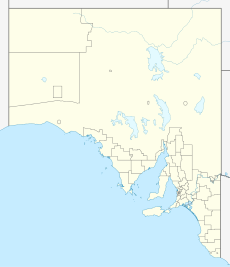Semaphore, South Australia
|
Semaphore Adelaide, South Australia |
|||||||||||||
|---|---|---|---|---|---|---|---|---|---|---|---|---|---|
 |
|||||||||||||
| Coordinates | 34°50′20″S 138°28′59″E / 34.839°S 138.483°ECoordinates: 34°50′20″S 138°28′59″E / 34.839°S 138.483°E | ||||||||||||
| Population | 2,832 (2006 census) | ||||||||||||
| Established | 1849 | ||||||||||||
| Postcode(s) | 5019 | ||||||||||||
| Location | 14 km (9 mi) from CBD | ||||||||||||
| LGA(s) | City of Port Adelaide Enfield | ||||||||||||
| State electorate(s) | Lee | ||||||||||||
| Federal Division(s) | Port Adelaide | ||||||||||||
|
|||||||||||||
| Footnotes | Coordinates Adjoining suburbs |
||||||||||||
Semaphore is a suburb in the Australian state of South Australia located in north-west of Adelaide on the Gulf St Vincent coastline of the LeFevre Peninsula about 14 kilometres (8.7 mi) from the Adelaide city centre.
Semaphore is bounded to the north by Union and Hargrave Streets, to the south by Hart Street, to the west by Gulf St Vincent and to the east by Woolnough Road and Swan Terrace. Semaphore is primarily a residential suburb, although its seaside location makes it a popular local tourist destination, with numerous restaurants, takeaway food outlets and other tourism-oriented businesses. It is adjacent to Semaphore South, Glanville, Exeter and Largs Bay. The postcode for Semaphore is 5019.
Semaphore was first surveyed for sale in 1849, at which time it was isolated by swamps to the south and the Port River to the east. In 1851, George Coppin, a prominent publican, theatrical entrepreneur and actor, built a two-storeyed timber hotel on the southern corner of The Esplanade and Blackler Street. A very high flagpole was erected to signal to his "White Horse Cellars" hotel at Port Adelaide the approach of ships, earning the area the name Semaphore, often called "The Semaphore".
In 1856, an official government signal station was established at the intersection of The Esplanade and Semaphore Road, where officers would record the details of all vessels in Gulf St Vincent. It was also used to record information on water depth, tides and cargo loading. A Telegraph Office opened in 1856 and became a Post and Telegraph Office in March 1871. In 1875, the Time Ball Tower was erected adjacent to the Signal Station. The area was isolated from Port Adelaide by the Port River until 1859 when a wooden bridge, later replaced by the Jervois Bridge, was opened. The following year saw the construction of the jetty. The majority of early settlers in Semaphore were crewmen of boats.
...
Wikipedia

